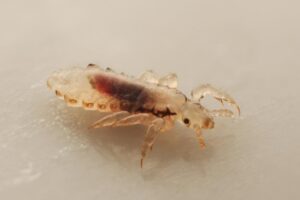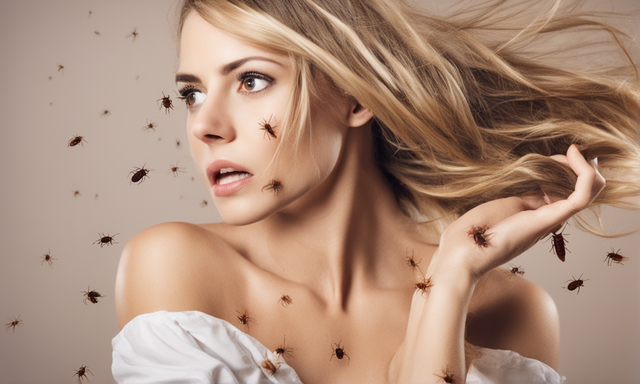Picture this: after a long tiring day, you snuggle into bed only to have thoughts about bed bugs racing through your mind. Not just any concern, but the nagging question, can bed bugs live in your hair? It’s the kind of thought that can keep you up, tossing and turning. So, let’s dive deep and dispel these nocturnal worries.
The Bed Bug Phenomenon
Bed bugs, known scientifically as Cimex lectularius, are tiny creatures that have been a part of human history for centuries. Originating from tropical climates, these pests adapted over time to cooler regions, and with the advent of international travel, they’ve become a global issue. Their bite is not only itchy and uncomfortable but also brings with it a psychological discomfort, knowing that tiny insects are feeding on you at night.
In modern times, the spread of bed bugs has become a widespread issue, especially in urban environments. They’ve been discovered in a variety of settings, from the ritziest hotels in major cities to suburban homes. Public transportation, libraries, theaters, and even offices are not immune. Their stealthy nature and ability to hide make them especially challenging to deal with, leading to their rapid proliferation in many urban centers.
You might be interested in: Can Bed Bugs Make You Sick?
Myths vs. Reality
Bed bugs have been surrounded by numerous myths, some born from old wives’ tales and others from genuine misunderstandings. One common misconception is that bed bugs are a result of poor hygiene or unclean living conditions. While they do thrive in cluttered environments due to more hiding places, they are just as happy in a spotless home if there’s a human to feed on.
Another myth is that bed bugs transmit diseases. Though their bites can cause itching and discomfort, they haven’t been shown to transmit any pathogens to humans. Still, their bites can lead to secondary infections if not kept clean and if continuously scratched. It’s essential to separate the facts from fiction to effectively deal with a bed bug infestation and not succumb to unnecessary panic.
The Biology of Bed Bugs
At the heart of understanding our tiny adversaries is knowing their biology. Bed bugs, despite their minuscule size, have a complex life cycle, starting as eggs, progressing through several nymph stages, and finally reaching adulthood. These stages can span over a month, during which they need regular blood meals to mature.
Adult bed bugs are reddish-brown, flat, and oval-shaped, growing up to 4-5 mm in length. They’re nocturnal, which means they’re most active during the night. They’re also equipped with anesthetic compounds in their saliva which numb the spot they bite, ensuring their host (often us) doesn’t feel a thing as they feed.
Where They Prefer to Reside
Bed bugs are ultimate survivalists. They’ve evolved to hide in the smallest of places, coming out only when it’s time to feed. While beds are their most notorious hideout, these pests have been found in numerous other spots. They can hide in furniture, curtain folds, under wallpaper, inside electronic devices, and even between floorboards.
The reason for their diverse choice of residence is their flat body, allowing them to squeeze into tight spots easily. Their preference always revolves around proximity to a food source. So, areas close to where humans rest or sleep are prime real estate for these pests. And while they can’t fly or jump, they’re excellent crawlers, enabling them to travel across rooms in search of their next meal or a new hiding spot.
Why Hair Isn’t Their First Choice
Now, to the crux of our concern: why don’t bed bugs prefer hair? Firstly, bed bugs are not designed to navigate through hair. Unlike lice, which have claws designed to cling to hair strands, bed bugs are adapted to move on smooth surfaces. This means navigating the dense forest of human hair is challenging for them.
Additionally, bed bugs prefer a stable environment to feed. The constantly moving landscape of a human scalp, with its regular movements and disturbances, is far from ideal. They like to feed undisturbed, and a moving scalp provides them little assurance of a calm meal. In essence, while it’s theoretically possible for a bed bug to end up in human hair, it’s not a habitat they’d choose willingly.
The Differences Between Lice and Bed Bugs
Lice and bed bugs are two common pests that can cause discomfort and distress to humans. While they share similarities in being blood-sucking parasites, they have distinct differences in behavior, appearance, and habitats. Understanding these differences is crucial for proper identification and subsequent treatment. The consequences of confusing the two can lead to mismanagement and prolonged infestations, causing further discomfort and potentially even financial burdens.
In recent years, the upswing in global travel and the exchange of second-hand furniture and clothing have caused a surge in bed bug infestations, while head lice continue to be a frequent issue, especially among school children. While both pests feed on human blood, their lifestyles, physical attributes, and habitats are quite distinct.
Physical Differences
At first glance, lice and bed bugs might seem similar, but upon closer inspection, their physical attributes reveal key distinctions. Lice are tiny, wingless insects with six legs that are adapted for holding onto hair. They live close to the scalp and lay their eggs, called nits, on hair shafts. These nits are often visible as small white or yellowish specks.
Bed bugs, on the other hand, are slightly larger, ranging from 1mm to 7mm in size. They are also wingless but possess a flat, oval-shaped body which is reddish-brown in color. Their body becomes more elongated and darker after feeding. Unlike lice, they don’t live on the human body but instead hide in cracks and crevices near sleeping areas.
Habitual Differences
When it comes to their habits and habitats, lice and bed bugs lead very different lives. Lice are highly adapted to live on their hosts. Head lice, for instance, remain on the scalp, feeding on blood and laying their eggs on hair strands. They can’t survive long without a human host. Their entire life cycle, from egg to adult, occurs on the human head.
Bed bugs, conversely, are more nomadic. They do not live on humans but rather in the vicinity, hiding in places like mattresses, furniture, and cracks in walls. They venture out mostly at night to feed on sleeping humans and then retreat to their hiding places. Unlike lice, bed bugs can survive for months without a blood meal.
Best Budget
Bed Bug Interceptors 8 Pack
4.0
- Bedbug Detection and Protection
- Effective, Heav Duty, Versatile Design
- Use under bed posts and furniture legs
- Bed bugs climb in but cannot climb out
We earn a commission if you make a purchase, at no additional cost to you.
12/18/2024 01:33 am GMT
Signs That Bed Bugs Might Be Close
One of the most distressing aspects of bed bugs is their stealthy nature. Often, their presence goes unnoticed until the infestation becomes severe. However, there are subtle signs that can hint at their proximity, allowing for early detection and intervention.
Bites and Marks
One of the primary indicators of a bed bug presence is their bites. These bites often appear as small, red, and itchy welts. They may be arranged in a linear pattern or clusters. While everyone’s reaction to bed bug bites varies, some might experience more significant swelling, intense itchiness, or even blisters. It’s essential to remember that not everyone reacts to bed bug bites, so while one person might show clear bite marks, another might not show any signs at all.
Other Warning Signs
Beyond bites, there are other indicators to be vigilant about. One such sign is small, rust-colored stains on bed linens or mattresses. These stains are the result of bed bugs being crushed or their excrement. Additionally, a sweet, musty odor might emanate from infested areas. This smell is produced by the bed bugs‘ scent glands. Another alarming sign is spotting the bugs themselves or their shed skins. Regularly inspecting beddings, mattresses, and bedroom furniture, especially when traveling or after acquiring second-hand furniture, can help in early detection.
Great Choice
Bed Bug and Egg Killer - Aerosol Spray
4.0
- Kills Bed Bugs & Their Eggs
- Surface spray to beds, mattresses and more
- Intended for indoor residential
- Helps to treat deep into cracks and crevices
We earn a commission if you make a purchase, at no additional cost to you.
12/18/2024 01:52 am GMT
Protecting Yourself from Bed Bugs
Protecting yourself from bed bugs involves proactive measures and a sharp sense of awareness. As we live in a time of frequent travel and the exchange of second-hand goods, the chances of bed bug encounters have increased. One crucial step is to regularly inspect your living areas, especially bedrooms. This includes checking the seams of mattresses, the undersides of furniture, and other hiding spots like cracks and crevices in walls. The importance of such inspections can’t be stressed enough, especially after hosting guests or traveling.
Moreover, when traveling, it’s a wise move to inspect the hotel room or accommodation before settling in. Pay special attention to the bed area, including sheets, pillows, and the mattress. Keeping luggage off the floor and using luggage racks, preferably after inspecting them, can prevent unwanted hitchhikers. Furthermore, using bed bug protective encasements for mattresses and pillows can create a barrier between you and potential infestations.
Precautions in Infested Areas
If you suspect you’re in an area with bed bugs or have confirmed their presence, it’s paramount to take precautions to prevent spreading them to other areas. Bed bugs are skilled hitchhikers, and without even realizing, you could transport them to your home or other places. When in infested areas, refrain from sitting or placing your belongings on beds or couches. Instead, opt for hard surfaces, as bed bugs find it difficult to navigate these.
Clothing is another avenue for bed bugs to travel. If you’ve spent time in a place with a confirmed infestation, it’s recommended to bag your clothes and launder them in high heat as soon as possible. The heat effectively kills bed bugs at all stages. Furthermore, when moving out of such areas, vacuuming your luggage and belongings can help pick up any stragglers. However, remember to dispose of the vacuum contents properly, sealing it in a bag and discarding it outside your living space.
Dealing with Infestations
Discovering a bed bug infestation in your living space can be distressing. However, while challenging, it’s a situation that can be managed with diligence and patience. The first step upon confirmation is not to panic. Relocating to another room or house might seem tempting, but this can potentially spread the infestation. Instead, focus on containing the situation.
Start by removing clutter from the affected area, as this reduces hiding spots for bed bugs. All clothing, bedding, and curtains should be laundered at the highest heat setting suitable for the fabrics. Items that can’t be laundered, like toys or shoes, can be placed in a dryer on high for about 30 minutes. Non-washable items can also be frozen, though they should remain in the freezer for several days. Simultaneously, using bed bug-specific sprays or treatments, especially on the bed and surrounding areas, can be effective. For severe infestations, it’s often best to consult professionals who have specialized treatments at their disposal. They can provide comprehensive solutions to ensure all bed bugs, including eggs, are eliminated.
You might be interested in: Why a Bamboo Pillow Can Be Your Best Sleep Companion









